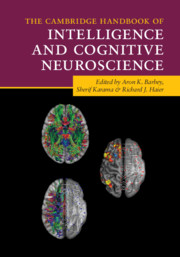Book contents
- The Cambridge Handbook of Intelligence and Cognitive Neuroscience
- Reviews
- The Cambridge Handbook of Intelligence and Cognitive Neuroscience
- Copyright page
- Dedication
- Contents
- Figures
- Tables
- Contributors
- Preface
- Part I Fundamental Issues
- Part II Theories, Models, and Hypotheses
- Part III Neuroimaging Methods and Findings
- 10 Diffusion-Weighted Imaging of Intelligence
- 11 Structural Brain Imaging of Intelligence
- 12 Functional Brain Imaging of Intelligence
- 13 An Integrated, Dynamic Functional Connectome Underlies Intelligence
- 14 Biochemical Correlates of Intelligence
- 15 Good Sense and Good Chemistry
- Part IV Predictive Modeling Approaches
- Part V Translating Research on the Neuroscience of Intelligence into Action
- Index
- References
11 - Structural Brain Imaging of Intelligence
from Part III - Neuroimaging Methods and Findings
Published online by Cambridge University Press: 11 June 2021
- The Cambridge Handbook of Intelligence and Cognitive Neuroscience
- Reviews
- The Cambridge Handbook of Intelligence and Cognitive Neuroscience
- Copyright page
- Dedication
- Contents
- Figures
- Tables
- Contributors
- Preface
- Part I Fundamental Issues
- Part II Theories, Models, and Hypotheses
- Part III Neuroimaging Methods and Findings
- 10 Diffusion-Weighted Imaging of Intelligence
- 11 Structural Brain Imaging of Intelligence
- 12 Functional Brain Imaging of Intelligence
- 13 An Integrated, Dynamic Functional Connectome Underlies Intelligence
- 14 Biochemical Correlates of Intelligence
- 15 Good Sense and Good Chemistry
- Part IV Predictive Modeling Approaches
- Part V Translating Research on the Neuroscience of Intelligence into Action
- Index
- References
Summary
The brain’s remarkable inter-individual structural variability provides a wealth of information that is readily accessible via structural Magnetic Resonance Imaging (sMRI). sMRI enables various structural properties of the brain to be captured on a macroscale level – one that is quickly moving towards submillimeter resolution (Budde, Shajan, Scheffler, & Pohmann, 2014; Stucht et al., 2015). This constitutes a remarkable leap forward from historically crude brain measures, such as head circumference measurements, aimed at understanding the neurobiology of intelligence differences.
- Type
- Chapter
- Information
- Publisher: Cambridge University PressPrint publication year: 2021



